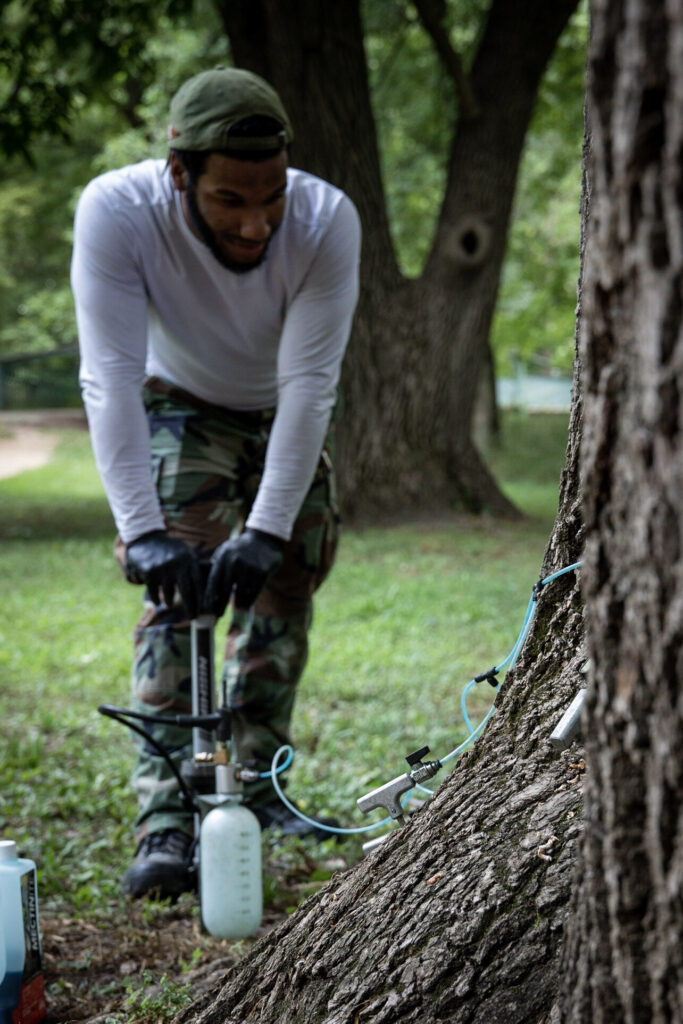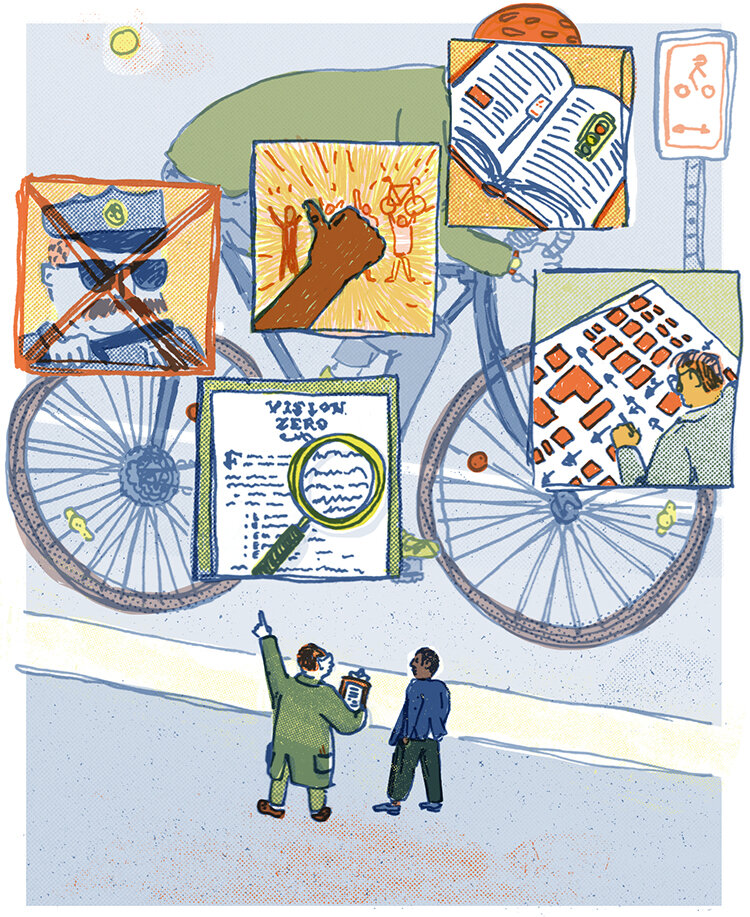Photography By Rachael Warriner
Graveyard Shift
By Constance Garcia-Barrio
If tombs are the clothes of the dead, as one poet said, permanent residents of cradle graves at The Woodlands Cemetery wear vivid garments indeed. Marble headstones, footstones and low sides form these graves while pansies, bleeding hearts, and other flowers bloom atop them and brim with color.
In Victorian times, when cradle graves became popular, family members tended the gardens in a kind of reunion with the deceased. But as relatives themselves died or moved away, weeds moved in.
Enter Jessica Baumert, 42, executive director of The Woodlands, and her staff, who launched the Grave Gardening program in 2015. Local gardening organizations provided funds, still the staff thought they might have a hard time getting people interested. Luckily, that was not the case.
“When we first asked for volunteer gardeners, we thought 20 people might respond,” Baumert says, “but over 70 showed up.” The staff stretched its budget to accept everyone.
A volunteer Grave Gardener at The Woodlands
The Grave Gardening program accords with The Woodlands’ horticultural heritage. In the 1760s William Hamilton (1745-1813), scion of a rich family of colonial lawyers, inherited 356 acres of land on the west bank of the Schuylkill River. Hamilton, though an amateur, became a megastar of botany, like William Bartram (1739-1823), author of “Bartram’s Travels” (1791), who lived 1 mile downriver. Hamilton built the nation’s first Federalist mansion, still extant, and a massive greenhouse, now gone.
He gained such fame that “…Lewis and Clark sent him two crates of seeds from their exploration of the western United States,” Baumert says. “Hamilton collected 9,000 native and imported plant specimens and introduced plants like the ginkgo tree to this country.”
Between 1813 and 1840, the Hamiltons went bankrupt. The property stood at the brink of being industrialized when some foresighted Philadelphians formed The Woodlands Cemetery Company in 1840 to “…preserve the beautiful scenery …” of the remaining acres of Hamilton’s estate, according to the articles of incorporation.
Members of the company—which included William H. Moore, who directed the funerals of Presidents Harrison, Taylor and John Quincy Adams—had the cemetery laid out in the rural cemetery style of meandering pathways and ornate monuments.
The Woodlands soared in popularity—at one point visitors needed a ticket to enter—with grave gardens one of its prime attractions. Well-heeled Philadelphians such as international art dealer Charles Haseltine (1840-1915), who handled some early works of controversial painter Thomas Eakins (1844-1916), including the “Gross Clinic,” has family cradle graves here, as does tooth manufacturer Samuel S. White (1822-1879), an inventor and businessman who employed a Black chemist when such a choice seemed radical. The author of a Victorian guidebook to Philadelphia deemed the graves “in the French style” a must-see. His description sparked Baumert’s idea for the Grave Gardening program.
Today’s 150 grave gardeners range from age 6 to retirees, and from master gardeners to novices. They have different reasons for volunteering.
“I have a reverence for the history of the space,” says Em Drucker, 28, who works in career services at Temple University. “I also run, picnic and spend time here with friends, and I’ve attended programs like Bat Night and the Tree Tour,” Drucker says of the 54-acre site, now a National
Historic District.
Something else moved Candice Thompson, 39, an unemployed nonprofit administrator, to volunteer. “It was part of my grieving process,” says Thompson, who sought to balance sadness she’s felt with her parents’ deaths in recent years. “The Grave Gardener program sounded like pure joy, and, as it turns out, totally is.”
Memories of gardening with her mother led Katharyn Coleman, 34, who teaches English to international students at Temple University, to try grave gardening. “Sometimes I would help my mother garden, and sometimes I would wander off,” Coleman says. But The Woodlands’ graves had long interested her. “My students would research and act out the lives of famous people buried here, then visit their graves on field trips.”
Each gardener adopts one, or occasionally more, graves, and spends on average two to four hours weekly gardening.
“Introductory workshops on horticultural history, the rural cemetery movement, and Victorian plants, give participants context,” says Robin Rick, 42, The Woodlands’ facilities and landscape manager and a grave gardener. “The program also provides soil, seeds, tools, everything gardeners need. About 185 of the 250 graves are being gardened. The rest are [far] from the water supply or in ill repair.”
A Planting Day—which took place in modified form this spring due to COVID-19—gets gardeners off to a good start and builds community. “We were far enough apart for social distancing guidelines,” Coleman says. “Robin and Jessica had stations where we consulted them
with questions.”
Gardeners pick from many plants appropriate for Victorian times. “I chose blackberry lilies for their height and structure, … [and] Kiwi Blue Cerinthe for its indigo bells which are attractive to pollinators…” Thompson says. “I’m a first-year gardener, so I tried to jam everything they were offering that liked sun into my plot.”
While the grave gardeners create visual delights, they sometimes find unexpected joy. Some say that gardening frees them to think through problems. Others, like Drucker, take pleasure in “…the tactile experience of putting my hands in the dirt.” Katharyn Coleman had a different surprise. “A fox came up to me while I was gardening,” she says. “He wasn’t expecting to see me there.”
Thompson’s rare experience of gardening at the grave of an ancestor leads her to quiet reflection. Jennie Lister, Thompson’s paternal great-great-great aunt, was interred at The Woodlands in 1876. “My father was the black sheep, so I knew little about that side of the family,” she says. “To be creating a garden in the family plot feels like an opportunity to connect … and linger in the halls of remembrance.”
The biggest challenges, gardeners say, are remembering to water the plants in summer—“I feel thirsty and recall that my plants may be thirsty,” Drucker says—“and keeping the plants safe from groundhogs,” Coleman says.
Despite these blips, gardeners feel rewarded, especially with the pandemic’s limit on in-person contact.
“The Woodlands is so peaceful, and that’s important now during COVID-19,” Drucker says. “It’s spread out. You can run, walk and rest, following distancing guidelines. The other day, another gardener was working nearby, but far enough away that we could talk. It was a gift.”

















